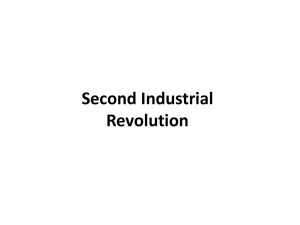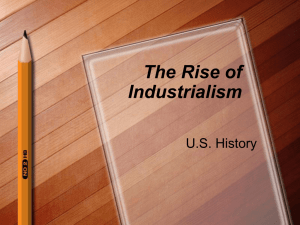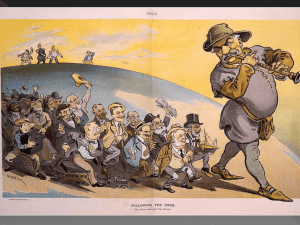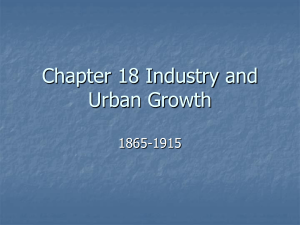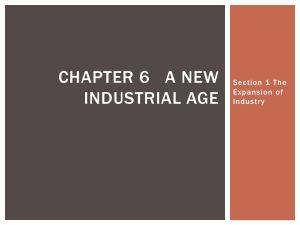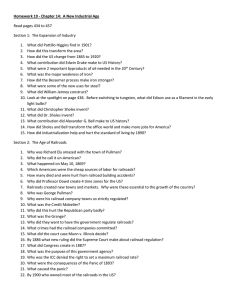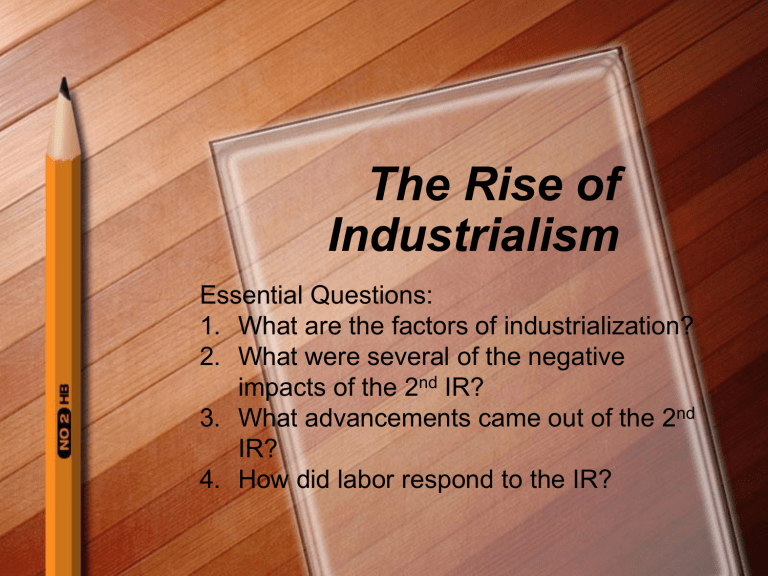
The Rise of Industrialism Essential Questions: 1. What are the factors of industrialization? 2. What were several of the negative impacts of the 2nd IR? 3. What advancements came out of the 2nd IR? 4. How did labor respond to the IR? The Rise of Industrialism A change from hand craftsmanship to machine manufacturing By 1900, the U.S. produced more industrial goods than any other country in the world Factors in Industrial Growth The following are reasons the U.S. was able to industrialize: 1) Abundant supply of natural resources – Oil, coal, timber, iron – All used to power factories and build goods Factors in Industrial Growth 2) Improved transportation methods (the railroad) – Businesses could transport goods from coast to coast – Farms on the west coast could buy tractors from the east coast Factors in Industrial Growth 3) Population shift: more people moved to urban areas – The population shift supplied factories with a large labor supply Factors in Industrial Growth 4) Government supported industrial growth by: – Subsidized railroad construction – Maintained a laissez-faire approach – Few taxes – No env. controls Factors in Industrial Growth 5) Talented entrepreneurs protected by the patent system Talk to your neighbor: What were the factors of Industrial growth in the U.S.? Railroads Nation’s first big business Promoted growth of other industries Modernization of the Railroads Development of standard time Many different local lines built w/ incompatible equipment Consolidation of competing railroads Railroad Gauges Trunk Lines: major route between large cities Western Railroads Gov’t gave 80 companies 170 million acres The Credit Mobilier scandal – Gov’t gave contracts + subsidies to the railroad industry/construction companies – Legislators were bribed – Companies overcharged and then kept the profits th 10 , May 1869 at Promontory Point, Utah Railroad Consolidation Competing companies agreed to fix rates Discounts for large companies Interstate Commerce Commission ineffective at first Talk to your neighbor: Why is the story of the railroad so important to U.S. history? Steel The “Bessemer Process” made producing steel faster and cost effective The skyscraper appeared Bridges held greater loads Steel railroads could carry steel railcars with heavy goods faster than iron railroads Andrew Carnegie Represented the American Dream Started a steel company By 1900 his company supplied 1/4 of all steel on the market Used vertical integration business model Philanthropist who wrote “The Gospel of Wealth” Rockefeller and Oil • Formed the company Standard Oil • Followed horizontal integration model • Controlled 90% of the country’s oil • Used ruthless tactics Integration Business Models The Rise of Trusts • Competing businesses combined to create monstrous firms called trusts. • Examples: • 5,300 independent manufacturers 319 Industrial trusts • 2,400 utilities companies (RR, electricity, water) 127 utility trusts • Same happens in oil, coal, steel, whiskey, sugar, tobacco, banking, farm machinery U.S. Corporate Mergers Anti-Trust Movement Gov’t slow to move Sherman Anti-Trust Act of 1890 Prohibited any “…conspiracy in restraint of trade or commerce.” Not effective, and only applied to commerce not manufacturing Electricity Becomes Widespread Businesses installed electrical elevators (made with steel) Factories installed lighting – Allowed factory to operate 24/7 Stores installed lighting and heating – Allowed stores to stay open later, and in cold weather The Telegraph • Speech is transmitted across electrical wires Telegraph and Morse Code http://www.histor y.com/topics/inv entions/telegrap h Marketing Consumer Goods Extravagant Wealth of Industrial Leaders Amassed fortunes Multiple homes worth millions of dollars Outrageous parties Horatio Alger Myth The Middle Class Rise of the Middle Class Jobs included managers, technical workers, sales people, industrial skilled workers Families who could earn a comfortable living and afford extra consumer goods on top of necessities Able to buy property and send children to college The Average American Lived in crowded city tenements or employer owned company towns Most still used candles to light homes, no indoor plumbing or heating Could not afford the consumer goods THEY were producing in factories Industrial Working Conditions “Become a hand – not a brain, not a soul – deadened into a part of a machine” • Most worked in steel mills, coal mines, garment factories, shipyards or on railroad tracks • 10-12 hours six days a week • Crowded, uncomfortable, dangerous factories • Monotonous work Discrimination in the Work Force Women: • entered the public work force • were paid half of what men earned Children: • 1.75 million children ages 6 15 worked in mines and factories in the late 1800s • worked the most dangerous jobs • young bodies suffered from deformities, asthma, stunted growth Minority Laborers: • New immigrants and African Americans did the most tedious jobs for the lowest pay • Business managers pitted ethnic groups against each other. Job/Ethnicity : Pay: Cigar Rollers/ 92% Chinese $287 per year Tailors/ 91% White $588 per year Talk to your neighbor: How did industrialization negatively impact Americans? Labor Unions Emerge • • • • Work collectively to be able to bargain w/ big business. 1897: 440,000 union workers 1904: 2M union workers Knights of Labor • Accepted women and Af-Am • Wanted an 8 hr work day, income tax, elimination of child labor, equal pay for men and women • American Federation of Labor (AFL) was a union for white, male, skilled workers. Business Response to Labor • Industrialists fought against unions • Often accused union leaders of being communists or terrorists • Gov’t supported big business -with anti-union legislation -breaking up strikes Strikes and Violence • Workers often went on strike, which means they refused to work until their demands were met • Many times, federal troops were called in to restore order and things turned violent • Great Railroad Strike • Haymarket Affair Strikes of the 1890s • Homestead Strike • Use of private guards and scabs • Set back labor movement • Pullman Strike • Involved Pullman sleeper cars • When workers went on strike, other trains carrying mail attached Pullman cars to the end • Federal gov’t intervened because of the disruption in mail service Union Victories • Eventually most business were forced to: -shorten work hours -compensate for injuries -stop hiring young children -provide breaks -improve health standards in work places Talk to your neighbor: What demands did labor unions make of big business? Why should Americans appreciate the work of labor unions in the late 19th and early 20th centuries?
